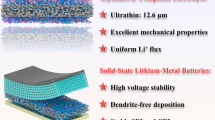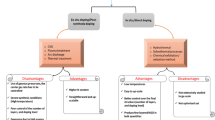Abstract
Free-standing and flexible NiMoO4 nanorods/reduced graphene oxide (rGO) membrane with a 3D hierarchical structure was successfully synthesized by a general approach including vacuum filtration followed by thermal reduction. NiMoO4 nanorods with about 50–100 nm diameter were embedded homogenously into the 3D rGO sheets and assembled with rGO to form a membrane about 10 μm in thickness. The NiMoO4/rGO membrane could be directly evaluated as anode materials for lithium-ion batteries (LIBs) without using binder. The 3D layer stacked graphene hierarchical architecture can not only offers a continuous conducting framework for efficient diffusion and transport of ion/electron but also accommodates the large volume expansion of NiMoO4 nanorod changes during cycling. Moreover, our results show that the NiMoO4/rGO membrane exhibited excellent electrochemical performance with a high reversible capacity of 945 mAh g−1 at a current density of 0.25 A g−1 as anode materials in LIBs.

ᅟ









Similar content being viewed by others
References
Armand M, Tarascon JM (2008) Building better batteries. Nature 451(7179):652–657
Goodenough JB, Kim Y (2010) Challenges for rechargeable Li batteries. Chem Mater 22(3):587–603
Doyle M, Fuller TF, Newman JS (1993) Modeling of galvanostatic charge and discharge of the lithium/polymer/insertion cell. J Electrochem Soc 140(6):1526–1533
Buqa H, Goers D, Holzapfel M (2005) High rate capability of graphite negative electrodes for lithium-ion batteries. J Electrochem Soc 152(2):A474–A481
Zhang SS, Xu K, Jow TR (2003) Effect of Li2CO3-coating on the performance of natural graphite in Li-ion battery. Electrochem Commun 5(12):979–982
Yasuda H, Higo M, Yoshitomi S (1997) Hydrogenation of tetralin over sulfided nickel-tungstate/alumina and nickel-molybdate/alumina catalysts. Catal Today 39(1-2):77–87
Xiao T, Suhartanto T, York APE (2003) Effect of molybdenum additives on the performance of supported nickel catalysts for methane dry reforming. Appl Catal A 253(1):225–235
Singh RN, Madhu, Awasthi R (2009) Preparation and electrochemical characterization of a new NiMoO4 catalyst for electrochemical O2 evolution. J Solid State Electrochem 13:1613–1619
Buhrmester T, Leyzerovich NN, Bramnik KG (2004) Electrochemical intercalation of lithium in ternary metal molybdates MMoO4(M=Cu, Zn). J Power Sources 127:76–84
Xiao W, Chen JS, Li CM, Xu R, Lou XW (2010) Synthesis, characterization, and lithium storage capability of AMoO4 (A = Ni, Co) nanorods. Chem Mater 22(3):746–754
Haetge J, Djerdj I, Brezesinski T (2012) Nanocrystalline NiMoO4 with an ordered mesoporous morphology as potential material for rechargeable thin film lithium batteries. Chem Commun 48(53):6726–6728
Kim JK, Kim JH, Kang YC (2018) Electrochemical properties of multicomponent oxide and selenide microspheres containing Co and Mo components with several tens of vacant nanorooms synthesized by spray pyrolysis. Chem Eng J 333:665–677
Cao ML, Bu Y, Lv XW, Jiang XX, Wang LC, Dai SR, Wang MK, Shen Y (2018) Three-dimensional TiO2 nanowire@NiMoO4 ultrathin nanosheet core-shell arrays for lithium ion batteries. Appl Surf Sci 435:641–648
Mai LQ, Yang F, Zhao YL (2011) Hierarchical MnMoO(4)/CoMoO(4) heterostructured nanowires with enhanced supercapacitor performance. Nat Commun 2:381
You NK, Kang YC, Park SB (2014) Superior cycling and rate performances of rattle-type CoMoO4 microspheres prepared by one-pot spray pyrolysis. RSC Adv 4:17873–17878
Ahn JH, Park GD, Kang YC (2015) Phase-pure β-NiMoO4 yolk-shell spheres for high-performance anode materials in lithium-ion batteries. Electrochim Acta 174:102–110
Xiao K, Xia L, Liu G, Wang S, Ding LX, Wang H (2015) Honeycomb-like NiMoO4 ultrathin nanosheet arrays for high-performance electrochemical energy storage. J Mater Chem A 3(11):6128–6135
Yang T, Zhang H, Luo Y (2015) Enhanced electrochemical performance of CoMoO4 nanorods/reduced graphene oxide as anode material for lithium-ion batteries. Electrochim Acta 158:327–332
Peng C, Chen B, Qin Y (2012) Facile ultrasonic synthesis of CoO quantum dot/graphene nanosheet composites with high lithium storage capacity. ACS Nano 6(2):1074–1081
Yoo E, Kim J, Hosono E (2008) Large reversible Li storage of graphene nanosheet families for use in rechargeable lithium ion batteries. Nano Lett 8(8):2277–2282
Wintterlin J, Bocquet ML (2009) Graphene on metal surfaces. Surf Sci 603(10-12):1841–1852
Li B, Cao H, Shao J (2011) Co3O4@graphene composites as anode materials for high-performance lithium ion batteries. Inorg Chem 50(5):1628–1632
Zhou G, Wang DW, Li F (2010) Graphene-wrapped Fe3O4 anode material with improved reversible capacity and cyclic stability for lithium ion batteries. Chem Mater 22(18):5306–5313
David L, Bhandavat R, Barrera U (2016) Silicon oxycarbide glass-graphene composite paper electrode for long-cycle lithium-ion batteries. Nat Commun 7:10998
Wu C, Kopold P, Aken PA (2017) High performance graphene/Ni2P hybrid anodes for lithium and sodium storage through 3D yolk-shell-like nanostructural design. Adv Mater 29(3):1604015
Shi JL, Du WC, Yin YX (2014) Hydrothermal reduction of three-dimensional graphene oxide for binder-free flexible supercapacitors. J Mater Chem A 2(28):10830–10834
Liu H, Wang H, Zhang X (2015) Facile fabrication of freestanding ultrathin reduced graphene oxide membranes for water purification. Adv Mater 27(2):249–254
Dikin DA, Stankovich S, Zimney EJ (2007) Preparation and characterization of graphene oxide paper. Nature 448(7152):457–460
Zhao X, Wang G, Wang H (2016) Synthesis of free-standing MnO2/reduced graphene oxide membranes and electrochemical investigation of their performances as anode materials for half and full lithium-ion batteries. J Nanopart Res 18(10):304
Moosavifard SE, Shamsi J, Fani S (2014) 3D ordered nanoporous NiMoO4 for high-performance supercapacitor electrode materials. RSC Adv 4(94):52555–52561
Wang X, Liu Q, Liu J (2017) 3D self-assembly polyethyleneimine modified graphene oxide hydrogel for the extraction of uranium from aqueous solution. Appl Surf Sci 426:1063–1074
Peng SJ, Li LL, Wu HB, Madhavi S, Lou XW (2015) Controlled growth of NiMoO4 nanosheet and nanorod arrays on various conductive substrates as advanced electrodes for asymmetric supercapacitors. Adv Energy Mater 5(2):1401172
Kazemi SH, Bahmani F, Kazemi H (2016) Binder-free electrodes of NiMoO4/graphene oxide nanosheets: synthesis, characterization and supercapacitive behavior. RSC Adv 6(112):111170–111181
Wang C, Wang X, Yang Y (2015) Slurryless Li2S/reduced graphene oxide cathode paper for high-performance lithium sulfur battery. Nano Lett 15(3):1796–1802
Hu T, Sun X, Sun H (2013) Flexible free-standing graphene–TiO2 hybrid paper for use as lithium ion battery anode materials. Carbon 51:322–326
Hu Y, Li X, Geng D (2013) Influence of paper thickness on the electrochemical performances of graphene papers as an anode for lithium ion batteries. Electrochim Acta 91:227–233
Zhang JT, Li Z, Lou XW (2017) A freestanding selenium disulfide cathode based on cobalt disulfide-decorated multichannel carbon fibers with enhanced lithium storage performance. Angew Chem Int Ed 56(45):14107–14112
Agyeman DA, Park M, Kang YM (2017) Pd-Impregnated NiCo2O4 nanosheets/porous carbon composites as a free-standing and binder-free catalyst for a high energy lithium–oxygen battery. J Mater Chem A 5(42):22234–22241
Pan YL, Cheng XD, Huang YJ, Gong LL, Zhang HP (2017) CoS2 nanoparticles wrapping on flexible freestanding multichannel carbon nanofibers with high performance for Na-ion batteries. ACS Appl Mater Interfaces 9(41):35820–35828
Feng H, Cheng R, Zhao X (2013) Corrigendum: a low-temperature method to produce highly reduced graphene oxide. Nat Commun 4:1539
Hummers WS, Offeman RE (1958) Preparation of graphitic oxide. J Am Chem Soc 80(6):1339
Dreyer DR, Park S, Bielawski CW (2014) The chemistry of graphene oxide. Chem Soc Rev 43(15):5288–5301
Jothi PR, Kannan S, Velayutham G (2015) Enhanced methanol electro-oxidation over in-situ carbon and graphene supported one dimensional NiMoO4 nanorods. J Power Sources 277:350–359
Hu RF, Zhao J, Zhu GD, Zheng JP (2018) Fabrication of flexible free-standing reduced graphene oxide/polyaniline nanocomposite film for all-solid-state flexible supercapacitor. Electrochim Acta 261:151–159
Ye ZB, Tai HL, Xie T, Su YJ, Yuan Z, Liu YC, Jiang YD (2016) A facile method to develop novel TiO2/rGO layered film sensor for detecting ammonia at room temperature. Mater Lett 165:127–130
Ghosh D, Giri S, Das CK (2013) Synthesis, characterization and electrochemical performance of graphene decorated with 1D NiMoO4·nH2O nanorods. Nano 5:10428–10437
Wang X, Houyong X, Gao J (2016) Enhanced cycle performance of ultraflexible asymmetric supercapacitors based on hierarchical MnO2@NiMoO4 core-shell nanostructure and porous carbon. J Mater Chem A 4(46):18181–18187
Li YF, Jian JM, Fan Y (2016) Facile one-pot synthesis of a NiMoO4/reduced graphene oxide composite as a pseudocapacitor with superior performance. RSC Adv 6(73):69627–69633
Stankovich S, Dikin DA, Piner RD (2007) Synthesis of graphene-based nanosheets via chemical reduction of exfoliated graphite oxide. Carbon 45(7):1558–1565
Wang B, Li S, Wu X (2015) Integration of network-like porous NiMoO4 nanoarchitectures assembled with ultrathin mesoporous nanosheets on three-dimensional graphene foam for highly reversible lithium storage. J Mater Chem A 3(26):13691–13698
Peng HJ, Hao GX, Chu ZH (2017) Porous carbon with large surface area derived from a metal–organic framework as a lithium-ion battery anode material. RSC Adv 7(54):34104–34109
Wang B, Li S, Wu X, Liu J, Tian W (2016) Hierarchical NiMoO4 nanowire arrays supported on macroporous graphene foam as binder-free 3D anodes for high-performance lithium storage. Phys Chem Chem Phys 18(2):908–915
Funding
This work was supported by the National Natural Science Foundation of China (no. 51672213), the Key Project of Research and Development of Shaanxi Province (no. 2017ZDCXL-GY-08-01), the Key Science and Technology Innovation Team Project of Natural Science Foundation of Shaanxi Province (no. 2017KCT-01), and the Natural Science Foundation of Shaanxi Province (no. 2017JM2025).
Author information
Authors and Affiliations
Corresponding authors
Rights and permissions
About this article
Cite this article
Li, X., Bai, J. & Wang, H. Synthesis of hierarchical free-standing NiMoO4/reduced graphene oxide membrane for high-performance lithium storage. J Solid State Electrochem 22, 2659–2669 (2018). https://doi.org/10.1007/s10008-018-3949-4
Received:
Revised:
Accepted:
Published:
Issue Date:
DOI: https://doi.org/10.1007/s10008-018-3949-4




